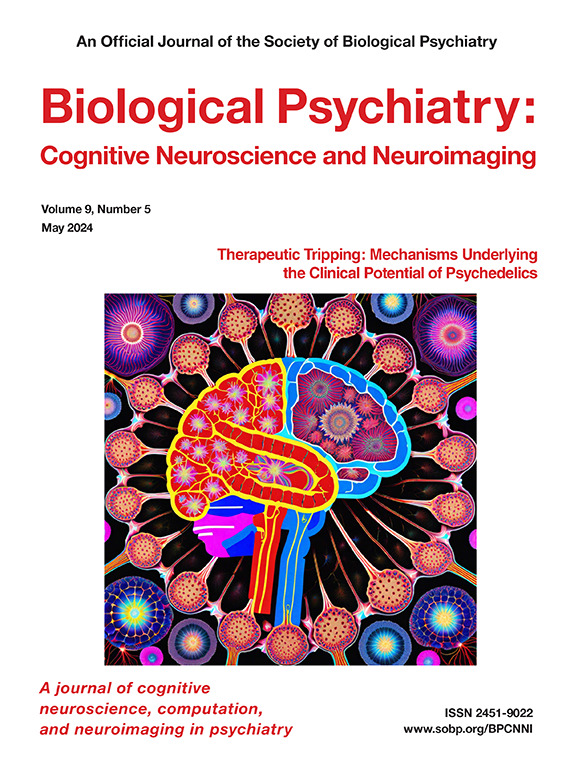Multivariate Links Between the Developmental Timing of Adversity Exposure and White Matter Tract Connectivity in Adulthood
IF 4.8
2区 医学
Q1 NEUROSCIENCES
Biological Psychiatry-Cognitive Neuroscience and Neuroimaging
Pub Date : 2025-09-01
DOI:10.1016/j.bpsc.2025.02.003
引用次数: 0
Abstract
Background
Early-life adversity is pervasive worldwide and represents a potent risk factor for increased mental health burden across the lifespan. However, there is substantial individual heterogeneity in associations between adversity exposure, neurobiological changes, and mental health problems. Accounting for key features of adversity such as the developmental timing of exposure may clarify associations between adversity, neurodevelopment, and mental health.
Methods
In the current study, we leveraged sparse canonical correlation analysis to characterize modes of covariation between adversity exposure across development and the connectivity of white matter tracts throughout the brain in a sample of 107 adults.
Results
We found that adversity exposure during preschool age and middle childhood (ages 4–5 and 8 years in particular) were consistently linked across diffusion metrics with alterations in white matter tract connectivity. Whereas tracts supporting sensorimotor functions showed higher connectivity with higher preschool-age and middle childhood adversity exposure, tracts supporting cortico-cortical communication showed lower connectivity. Furthermore, latent patterns of tract connectivity associated with adversity experienced across preschool age and middle childhood (ages 3–8) were associated with posttraumatic stress symptoms in adulthood.
Conclusions
Our findings underscore that adversity exposure may differentially affect white matter in a function- and developmental timing–specific manner and suggest that adversity experienced from ages 3 to 8 years may shape the development of white matter tracts across the brain in ways that are relevant for mental health in adulthood.
逆境暴露的发育时间与成年期白质束连通性之间的多变量联系。
背景:生命早期的逆境在世界范围内普遍存在,并且是整个生命周期中心理健康负担增加的一个潜在风险因素。然而,逆境暴露、神经生物学变化和心理健康问题之间的关联存在实质性的个体异质性。考虑到逆境的关键特征,如暴露的发育时间,可能会澄清逆境、神经发育和心理健康之间的联系。方法:本研究利用稀疏典型相关分析来表征107名成年人在发育过程中逆境暴露与整个大脑白质束连通性之间的共变模式。结果:我们发现,在学龄前和儿童中期(特别是4-5岁和8岁),逆境暴露在扩散指标上与白质束连通性的改变始终相关。支持感觉运动功能的神经束在学龄前和儿童中期逆境暴露中表现出较高的连通性,而支持皮质-皮质通讯的神经束表现出较低的连通性。此外,与学龄前和儿童中期(3-8岁)经历的逆境相关的尿道连通性的潜在模式与成年后的创伤后应激症状有关。结论:我们的研究结果强调,逆境暴露可能会以功能和发育时间特定的方式对白质产生不同的影响,并表明3-8岁之间经历的逆境可能会以与成年期心理健康相关的方式塑造大脑白质束的发育。
本文章由计算机程序翻译,如有差异,请以英文原文为准。
求助全文
约1分钟内获得全文
求助全文
来源期刊

Biological Psychiatry-Cognitive Neuroscience and Neuroimaging
Neuroscience-Biological Psychiatry
CiteScore
10.40
自引率
1.70%
发文量
247
审稿时长
30 days
期刊介绍:
Biological Psychiatry: Cognitive Neuroscience and Neuroimaging is an official journal of the Society for Biological Psychiatry, whose purpose is to promote excellence in scientific research and education in fields that investigate the nature, causes, mechanisms, and treatments of disorders of thought, emotion, or behavior. In accord with this mission, this peer-reviewed, rapid-publication, international journal focuses on studies using the tools and constructs of cognitive neuroscience, including the full range of non-invasive neuroimaging and human extra- and intracranial physiological recording methodologies. It publishes both basic and clinical studies, including those that incorporate genetic data, pharmacological challenges, and computational modeling approaches. The journal publishes novel results of original research which represent an important new lead or significant impact on the field. Reviews and commentaries that focus on topics of current research and interest are also encouraged.
 求助内容:
求助内容: 应助结果提醒方式:
应助结果提醒方式:


